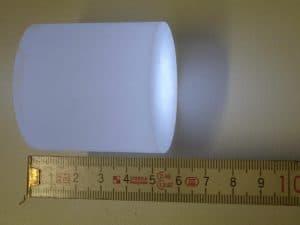
Cesium iodide (CsI) in crystalline form is used as the scintillator for detecting protons and alpha particles. Pure CsI is a fast and dense scintillating material with a relatively low light yield that increases significantly with cooling. The drawbacks of CsI are a high-temperature gradient and a slight hygroscopicity.
Thallium-doped Caesium Iodide has an effective atomic number of 54 and a density of 4.51 g/cm3. CsI(TI) is also hygroscopic and should not be subjected to high humidity or water. CsI(TI) has different decay times for different particles (680ns and 3340ns) and can be used to determine different kinds of radiation. The emission spectrum peaked at 540-560 nm.
Scintillation counters can be used to detect alpha, beta, and gamma radiation, and they can also be used for detection of neutrons. For these purposes, different scintillators are used:
- Alpha Particles and Heavy Ions. Due to the very high ionizing power of heavy ions, scintillation counters are usually not ideal for the detection of heavy ions. For equal energies, a proton will produce 1/4 to 1/2 the light of an electron, while alpha particles will produce only about 1/10 the light. Where needed, inorganic crystals, e.g., CsI(Tl) and ZnS(Ag) (typically used in thin sheets as α-particle monitors), should be preferred to organic materials. Pure CsI is a fast and dense scintillating material with a relatively low light yield that increases significantly with cooling. The drawbacks of CsI are a high-temperature gradient and a slight hygroscopicity.